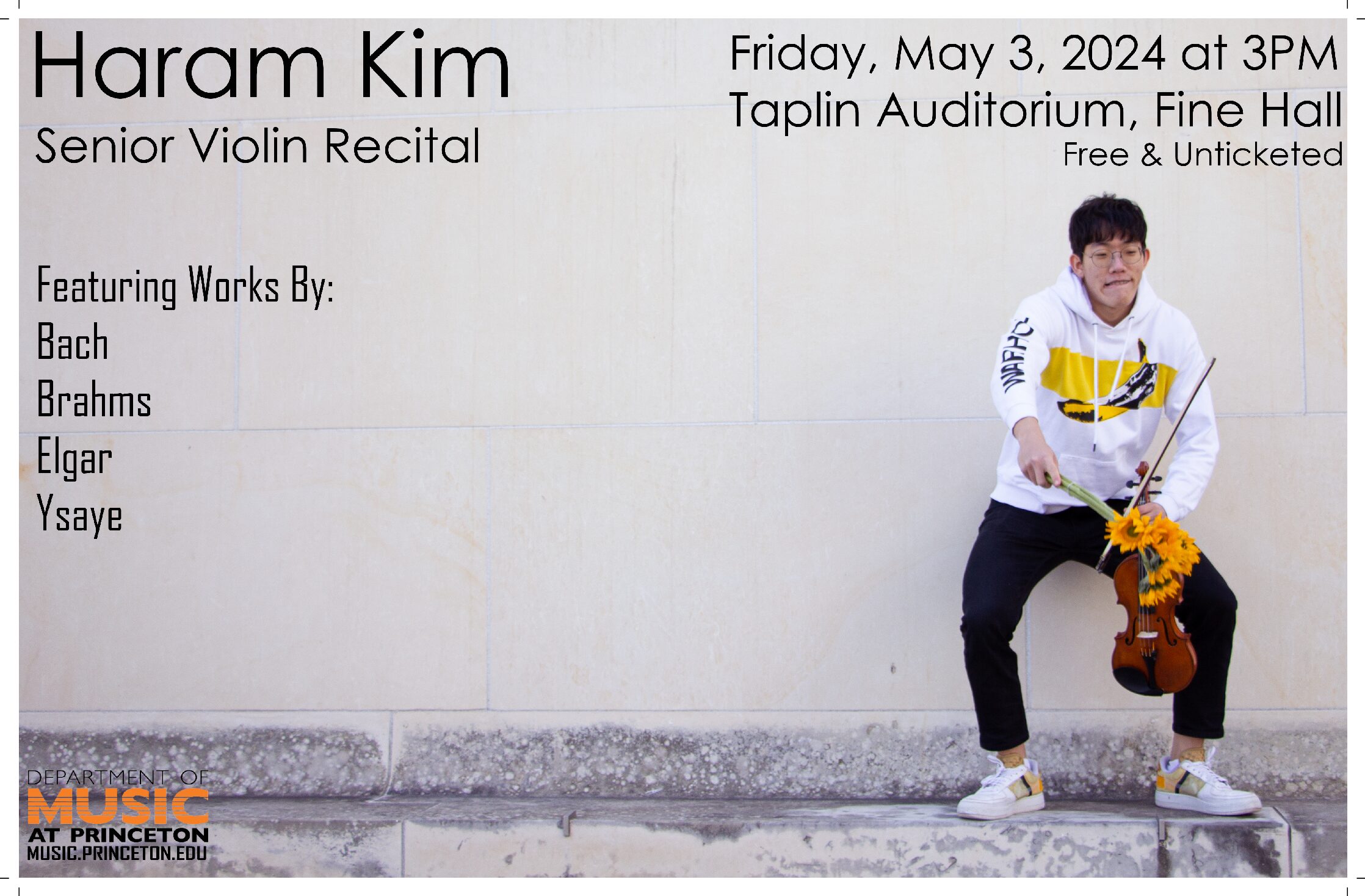Please consult our COVID-19 policies and resources for guidance on attending public performances.

Certificate Recital: Haram Kim, Violin
Presented by Princeton University Music Department
date & time
Fri, May 3, 2024
3:00 pm
ticketing
Free, unticketed
- This event has passed.

Haram Kim ’24 (Violin) performs a senior recital.
Program
Johann Sebastian Bach Sonata No. 3 in C major, BMV 1005: Allegro assai
Edward Elgar Sonata in E minor, Op. 82
Cherry Ge, piano
Eugene Ysaye Sonota No. 3 "Ballade"
Johannes Brahms Scherzo in C minor, F.A.E Sonata
Kritin "The Bomb" Vongthonsri, piano
Ernest Chausson Piano Quartet in A major, Op.30: II - Très calme
Cherry Ge, piano
Aster Zhang, cello
Albert Zhou, viola
Program Notes
Bach Violin Sonata No. 3: Allegro assai
Johann Sebastian Bach’s Violin Sonata No. 3 in C Major, BWV 1005, stands as a pinnacle of Baroque violin repertoire. Composed around 1720, it is part of a set of six sonatas and partitas for solo violin. The Allegro Assai, the third movement of this sonata, exemplifies Bach’s mastery of counterpoint, harmonic complexity, and sheer technical brilliance. In this movement, Bach unfolds a tapestry of intricate musical ideas, showcasing the violin’s agility and expressiveness. The Allegro Assai is characterized by its lively tempo, propulsive rhythm, and joyful energy. From the opening bars, the violin engages in a spirited dialogue with itself, weaving through cascading arpeggios, virtuosic runs, and elaborate ornamentation.
Elgar Violin Sonata
Sir Edward Elgar’s Violin Sonata in E Minor, Op. 82, is a poignant and deeply expressive work that reflects the composer’s mature style and emotional depth. Completed in 1918, during the aftermath of World War I, the sonata captures the spirit of its time with its introspective melodies and rich harmonic language. The sonata is structured in four movements: Allegro, Romance, Allegro non troppo, and Allegro, with the first movement setting the tone for the entire work. The opening Allegro presents a wealth of thematic material, ranging from melancholic to triumphant, as the violin and piano engage in a captivating dialogue filled with dramatic tension and tender lyricism. The heart of the sonata lies in the second movement, Romance, where Elgar’s gift for melody shines brightly. Here, the violin sings a soulful lament over a gentle piano accompaniment, evoking a sense of longing and nostalgia. The music unfolds with a bittersweet beauty, conveying the depth of human emotion in the wake of conflict and loss. The third movement, Allegro non troppo, brings a sense of urgency and vitality, with driving rhythms and bold gestures that propel the music forward. The violin and piano engage in spirited interplay, exploring themes of resilience and hope amidst adversity. Elgar offered to dedicate it to a family friend, Marie Joshua, and wrote to her: “I fear it does not carry us any further but it is full of golden sounds and I like it, but you must not expect anything violently chromatic or cubist”
Ysaye Sonata No. 3 “Ballade”
The Ballade No. 3 is a tour de force of technical prowess and expressive depth. From its hauntingly lyrical opening to its exhilarating finale, Ysaÿe weaves a narrative of passion, drama, and introspection through the voice of the violin. The piece unfolds in a single continuous movement, with themes and motifs recurring and evolving throughout. Ysaÿe explores a wide range of violin techniques, from delicate passages of double stops and harmonics to fiery virtuosic runs and rapid arpeggios. At its core, the Ballade No. 3 is a deeply emotional work, imbued with a sense of longing and nostalgia. Ysaÿe’s melodic lines soar and sigh, expressing a depth of feeling that transcends words. The structure of the piece is organic and free-flowing, with Ysaÿe allowing the music to unfold naturally, guided by the expressive possibilities of the violin. The Ballade builds to a thrilling climax, with the violinist’s fingers flying across the strings in a dazzling display of technical prowess.
Brahms Scherzo from F.A.E Sonata
The F.A.E Sonata was written by Albert Dietrich, Robert Schumann, and Johannes Brahms as a gift for Joseph Joachim. Schumann decided on the motto for the piece Frei aber einsam – meaning “free but lonely.” A piece of elegance and refinement that shows innate understanding of balance and control, Brahms truly understood what it meant to be lonely.
Chausson Piano Quartet in A major II- Très calme
In this tranquil and contemplative movement, Chausson explores a palette of subdued colors and delicate textures. The piano sets the stage with gentle arpeggios and harmonies that evoke a sense of stillness and repose, while the strings weave a delicate tapestry of melodies that shimmer and sway like leaves in a gentle breeze. The interplay between the instruments is characterized by a sense of intimacy and unity, with each voice contributing to the overall sense of tranquility and contemplation. Themes are passed seamlessly from one instrument to another, creating a seamless web of sound that envelops the listener in a state of quiet reflection.
Program Notes
Bach Violin Sonata No. 3: Allegro assai
Johann Sebastian Bach’s Violin Sonata No. 3 in C Major, BWV 1005, stands as a pinnacle of Baroque violin repertoire. Composed around 1720, it is part of a set of six sonatas and partitas for solo violin. The Allegro Assai, the third movement of this sonata, exemplifies Bach’s mastery of counterpoint, harmonic complexity, and sheer technical brilliance. In this movement, Bach unfolds a tapestry of intricate musical ideas, showcasing the violin’s agility and expressiveness. The Allegro Assai is characterized by its lively tempo, propulsive rhythm, and joyful energy. From the opening bars, the violin engages in a spirited dialogue with itself, weaving through cascading arpeggios, virtuosic runs, and elaborate ornamentation.
Elgar Violin Sonata
Sir Edward Elgar’s Violin Sonata in E Minor, Op. 82, is a poignant and deeply expressive work that reflects the composer’s mature style and emotional depth. Completed in 1918, during the aftermath of World War I, the sonata captures the spirit of its time with its introspective melodies and rich harmonic language. The sonata is structured in four movements: Allegro, Romance, Allegro non troppo, and Allegro, with the first movement setting the tone for the entire work. The opening Allegro presents a wealth of thematic material, ranging from melancholic to triumphant, as the violin and piano engage in a captivating dialogue filled with dramatic tension and tender lyricism. The heart of the sonata lies in the second movement, Romance, where Elgar’s gift for melody shines brightly. Here, the violin sings a soulful lament over a gentle piano accompaniment, evoking a sense of longing and nostalgia. The music unfolds with a bittersweet beauty, conveying the depth of human emotion in the wake of conflict and loss. The third movement, Allegro non troppo, brings a sense of urgency and vitality, with driving rhythms and bold gestures that propel the music forward. The violin and piano engage in spirited interplay, exploring themes of resilience and hope amidst adversity. Elgar offered to dedicate it to a family friend, Marie Joshua, and wrote to her: “I fear it does not carry us any further but it is full of golden sounds and I like it, but you must not expect anything violently chromatic or cubist”
Ysaye Sonata No. 3 “Ballade”
The Ballade No. 3 is a tour de force of technical prowess and expressive depth. From its hauntingly lyrical opening to its exhilarating finale, Ysaÿe weaves a narrative of passion, drama, and introspection through the voice of the violin. The piece unfolds in a single continuous movement, with themes and motifs recurring and evolving throughout. Ysaÿe explores a wide range of violin techniques, from delicate passages of double stops and harmonics to fiery virtuosic runs and rapid arpeggios. At its core, the Ballade No. 3 is a deeply emotional work, imbued with a sense of longing and nostalgia. Ysaÿe’s melodic lines soar and sigh, expressing a depth of feeling that transcends words. The structure of the piece is organic and free-flowing, with Ysaÿe allowing the music to unfold naturally, guided by the expressive possibilities of the violin. The Ballade builds to a thrilling climax, with the violinist’s fingers flying across the strings in a dazzling display of technical prowess.
Brahms Scherzo from F.A.E Sonata
The F.A.E Sonata was written by Albert Dietrich, Robert Schumann, and Johannes Brahms as a gift for Joseph Joachim. Schumann decided on the motto for the piece Frei aber einsam – meaning “free but lonely.” A piece of elegance and refinement that shows innate understanding of balance and control, Brahms truly understood what it meant to be lonely.
Chausson Piano Quartet in A major II- Très calme
In this tranquil and contemplative movement, Chausson explores a palette of subdued colors and delicate textures. The piano sets the stage with gentle arpeggios and harmonies that evoke a sense of stillness and repose, while the strings weave a delicate tapestry of melodies that shimmer and sway like leaves in a gentle breeze. The interplay between the instruments is characterized by a sense of intimacy and unity, with each voice contributing to the overall sense of tranquility and contemplation. Themes are passed seamlessly from one instrument to another, creating a seamless web of sound that envelops the listener in a state of quiet reflection.

